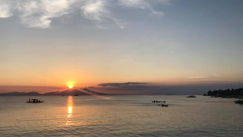
The Island
The island of Biri is located in the northernmost tip of the province of Northern Samar, facing the blue sea of the Pacific Ocean to the East and the famous San Bernardino Strait to the west.
History-wise, Biri was once a barrio of municipality of Bobon established in 1649, and had this barangay, until its conversion into a new and independent municipality under Republic Act No. 5500 sponsored by then Congressman Eusebio B. Moore and passed by the Sixth Congress on June 21, 1969. Thus, Biri became the 21st municipality and its first municipal officials were elected on November 1969 special election. This island used to be “Tingiao” as referred to in the navigation maps of the spanish galleons, was the entry point to Luzon and Visayas. As a navigational landmark, the name Biri was derived the Spanish word “barrer” meaning to “sweep”. Every time the Spanish captain of the Gality of the province when her first municipal Galleon would sight the San Bernardino Isle of Biri or Tingiao, the captain would order his men to “barrer” which means “to sweep” or “clean” the galleon deck, and the “tripulante” would do so in preparation to berthing the Capul Island for its trip to manila. Other versions would say that its name in the course of time, became, simple “Biri” depending on the person auditory “efficacy. But Biri came to be known to sailors who passed by the island, and contribute to the navigational ventures and efforts of the Spaniards during all those galleon years.
During the last World War II, Biri was the site of the Japanese Garrison signal Corps for its strategic location from the Pacific Ocean. Many Biri-anons became witnesses to the Passing of the American Submarines and warship during the Liberation of Leyte and a bomb-made lagoon is still existeng inside the Biri Central Elementary School Campus. It was a result when the signal corps of the Japanese Imperial Armay was helplessly bombed by the Filipino-American combined forces on October 24-25, 1945. Many inhabitants had witnessed the horror and damage in 2-day battle in Biri leaving not single Japanese soldiers alive.
Geographically, her inhabitants were a blend of Waray and Bicolano Culture. Most of the inhabitants were themselves evidence of cross culture. The inner islanders speak Waray dialect and the outer island people speak Bicol-Waray dialect. The Former islanders tend to frequent the Northern Samar areas and the latter travel and make contacts with the southern Bicol towns, mostly in Gubat, Bulosan, Matnog and Sorsogon. The long years of trading has made Biri-Anons the heir of the culture gains from this which accounts the fine fine taste of living.
The Municipality comprises of eight (8) Barangays. Four of which are located in separate islands. Brgy. San Antonio, Brgy. San Pedro, Brgy. Mac arthur and Brgy. Pio del pilar.
The Natural Resources of the Municipality consist mainly of fish and other marine products. The inhabitants are also engaged in rice farming, root crops and coconut production. During the months of March and September, the inhabitants are engaged in catching fish and squids. A school of squids are caught which provide the main fishery resources of the people It is said that Biri becomes a “City of Lights” when people are out of the sea catching squids
Source: https://biriisland.wordpress.com/the-local-government-unit/68-2/













